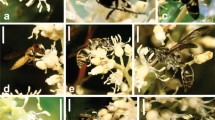Summary
Six estimates of resource allocation to sexual reproduction (nectar concentration, nectar volume, sugar production, pollinator visitation rates, fruit-set, and seed production) and a single estimate of resource allocation to asexual reproduction (the rate of rooted-branch production) were examined for five species of Mimulus. There were significant interspecific differences for all paramaters. With the exception of nectar concentration, there was 1) a consistent positive correlation among the parameters measuring allocation to sexual reproduction, and 2) a significant negative correlation between parameters measuring allocation to sexual reproduction and the rate of rooted-branch production (asexual reproduction). The results indicate that Mimulus species which produce the highest volumes of nectar 1) receive the most pollinator visits, 2) have the highest fruit-set, 3) produce the most seeds, and 4) produce the fewest rooted branches.
Similar content being viewed by others
References
Abrahamson WG (1975) Reproductive strategies in dewberries. Ecol 56:721–726
Antonovics J (1980) Concepts of resource allocation and partitioning in plants. In: Staddon JER (ed) The Allocation of Individual Behavior. Academic Press, New York, pp 1–25
Ashmun JW, Brown RL, Pitelka LF (1985) Biomass allocation in Aster acuminatus: variations within and among populations over five years. Can J Bot 63:2035–2043
Baker HG (1975) Sugar concentrations in nectars from hummingbird flowers. Biotropica 7:37–41
Bazzaz FA, Chiariello NR, Coley PD, Pitelka LF (1987) Allocating resources to reproduction and defense. BioScience 37:58–67
Bolten AB, Feinsinger P, Baker HG, Baker I (1979) On the calculation of sugar concentration in flower nectar. Oecologia (Berlin) 41:301–304
Corbet SA (1978) Bees and the nectar of Echium vulgare. In: Richards AJ (ed) The pollination of Flowers by Insects. Academic Press, London, pp 21–29
CRC handbook of chemistry and physics, 59th ed (1978) The Chemical Rubber Co., Cleveland, Ohio, p D-261
Davis LD (1957) Flowering and alternate bearing. Proc Amer Soc Hort 70:545–556
Eis S, Garman EH, Ebell LF (1965) Relationship between cone production and diameter increment of Douglas fir, Grand fir, and western white pine. Can J Bot 43:1553–1559
Harper JL (1977) Population Biology of Plants. Academic Press, London, pp 1–892
Heyneman AJ (1983) Optimal nectar concentrations of floral nectars: dependence on sugar intake efficiency and foraging costs. Oecologia (Berlin) 60:198–213
Hickman JC (1975) Environmental unpredictability and plastic energy allocation strategies in the annual Polygonum cascadense (Polygonaceae). J Ecol 63:689–701
Hiesey WM, Nobs MA, Bjorkman O (1971) Experimental studies on the nature of species. Carnegie Insitution of Washington. Publications 628, Washington, pp 1–213
Holler LC, Abrahamson WG (1977) Seed and vegetative reproduction in relation to density in Fragaria virginiana (Rosaceae). Am J Bot 64:1003–1007
Holmsgaard E (1955) Tree ring analysis of Danish forest trees. Det Forstl 22:1–246
Johnsgard PA (1983) The Hummingbirds of North America. Smithsonian Institution Press, Washington, pp 1–303
Kingsolver JG, Daniels TL (1983) Mechanical determinants of nectar feeding strategy in hummingbirds: energetics, tongue morphology, and licking behavior. Oecologia (Berlin) 60:214–226
Kozlowski TT (1971) Growth and Development of Trees, vol 2. Academic Press, New York, pp 1–514
Kramer PJ, Kozlowski TT (1979) Physiology of Woody Plants. Academic Press, New York, pp 1–809
Langer RHM, Tyle SM, Jewiss OR (1964) The changing plant and tiller populations of timothy and meadow fescue swards. I. Plant survival and the patterns of tillering. Jour Appl Ecol 1:196–208
Michaels HJ, Bazzaz FA (1986) Resource allocation and demography of sexual and apomictic Antennaria parlinii. Ecol 67:27–36
Molish H (1938) The Longevity of Plants. Science Press, Lancaster, PA
Morris RF (1951) The effects of flowering on the foliage production and growth of balsam fir. Forest Chron 27:40–57
Ogden J (1974) The reproductive strategy of higher plants. II. The reproductive strategy of Tussilago farfara. J Ecol 62:391–324
Percival MS (1974) Floral ecology of coastal shrubs in southeast Jamaica. Biotropica 6:104–129
Pinero D, Sarukhan J, Alberdi P (1982) The cost of reproduction in a tropical palm, Astrocaryum mexicanum. J Ecol 70:473–481
Pitelka LF, Stanton DS, Peckenham MO (1980) Effects of light and density on resource allocation in a forest herb, Aster acuminatus (Compositae). Amer J Bot 67:942–948
Pyke GH, Waser NM (1981) The production of dilute nectars by hummingbird and honeyeater flowers. Biotropica 13:260–270
Rogers WS, Booth GA (1964) Relationship of crop and shoot growth in apple. J Hort Sci 39:61–65
Sarukhan J (1976) On selective pressures and energy allocation in populations of Ranunculus repens, L. R. bulbosus L, and R. acris. L. Ann Mo Bot Gard 63:290–308
Singh LB (1948) Studies in biennial bearing. III. Growth studies in the “on” and “off” year trees. J Hort Sci 24:123–148
Sokal RR, Rohlf FJ (1969) Biometry. WH Freeman and Co. San Francisco, pp 1–776
Vickery RK (1978) Case studies in the evolution of species complexes in Mimulus. In: Hecht MK, Steere WC, Wallace B (eds) Evolutionary Biology. Plenum Publishing Corp, New York, pp 405–507
Vickery RK, Phillips DR, Wonsavage PR (1985) Seed dispersal in Mimulus guttatus by wind and deer. Am Mid Nat 116:206–208
Author information
Authors and Affiliations
Rights and permissions
About this article
Cite this article
Sutherland, S., Vickery, R.K. Trade-offs between sexual and asexual reproduction in the genus Mimulus . Oecologia 76, 330–335 (1988). https://doi.org/10.1007/BF00377025
Received:
Issue Date:
DOI: https://doi.org/10.1007/BF00377025




